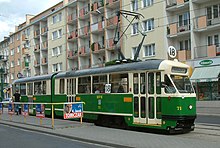Konstal


Alstom Konstal (until 1997 Konstal ) is a Polish manufacturer of trams and other rail vehicles.
19th century
The plant in Chorzów ( Upper Silesia ) emerged from the wagon construction company ( wheelwright ) of the originally state-owned steelworks Königshütte, founded in 1797 in what was then Königshütte OS . Since 1864, components for the railroad have also been produced there. In 1871 the companies of Königshütte and the neighboring Laurahütte, founded in 1838, were merged to form the United Königs- und Laurahütte AG . Since the end of the 19th century, the Wagenbauanstalt also built rail freight cars.
20th century
After parts of Upper Silesia were ceded by the German Reich to Poland in 1922, the wagon factory, like all parts now located in Poland, was continued under the name Górnośląskie Zjednoczone Huty Królewska i Laura SA as a stock corporation under Polish law from 1925/26 .
After the end of the First World War, the wagon factory began manufacturing tram cars and building bridges, but was still organizationally connected to a steelworks now known as Huta Piłsudski . It was not until 1927 that the wagon construction division was split off under the name of Chorzowska Wytwórnia Konstrukcji Stalowych (Chorzower Factory of Steel Structures). The abbreviation Konstal arose from the initial syllables of the last two words.
After Poland was broken up and Eastern Upper Silesia was reintegrated into the German Empire in World War II , the company ran under the name OSMAG (Oberschlesische Maschinen- und Waggonfabrik AG) .
Back in Poland after the Second World War, the plant was renamed Konstal again in 1947. From 1948 to 1962 over 3000 tram cars of the types Konstal N to Konstal 5N were built here , developed from the German war tram car .
After the Warsaw tram received two Czech type Tatra T1 multiple units in 1955 , a replica of this type was planned in Chorzów with only minor changes. 845 railcars were built between 1959 and 1969, almost exclusively for Warsaw.
From the 13N a six-axle version was developed as type 15N with Jakobs bogie with unchanged engine. A prototype was built in 1967, series production with modified car bodies with angular fronts took place in 1969 as type 102N ( meter gauge 802N) with a total of 47 pieces. From 1970 to 1974 a modified version with the front design of the 13 N was built as type 102Na . Including the subtypes 102Nd, 102NaW and 803N (the latter two for meter gauge), a total of 676 railcars were built.
In 1973 a completely new type of tram was designed with the Konstal 105N , with a return to the four-axle construction method. From 1973 to 1979 984 railcars were built, four of which were meter-gauge versions as type 105NW. From 1979, the improved type Konstal 105Na was built almost unchanged from the outside , also in meter-gauge version as type 805Na. A total of 2141 railcars had been built by 1992. Subsequently, modified variants were created (partly also as conversions), which have different characteristics depending on the tram operation.
present
The plant went through a critical phase during the transition from planned to market economy. As a more modern product, two three - part articulated wagons with a low-floor middle section (Konstal 114Na) were built in 1997 .
In 1997 Konstal was bought by the French group ALSTOM . Since then the company has been called ALSTOM Konstal. The number of employees was reduced from 8500 to 2000 through drastic rationalization. Modern low-floor trams are now being built here (Konstal NGd99, Konstal 116Nd, Konstal 105N2k / 2000).
literature
Arkadiusz Lubka, Marcin Stiasny: Atlas tramwajów . Poznański Klub Modelarzy Kolejowych, Poznań 2004, ISBN 83-920757-0-6 .
Weblinks Konstal
Individual evidence
- ↑ Hopes in the scrap in ZEIT ONLINE from 1997


